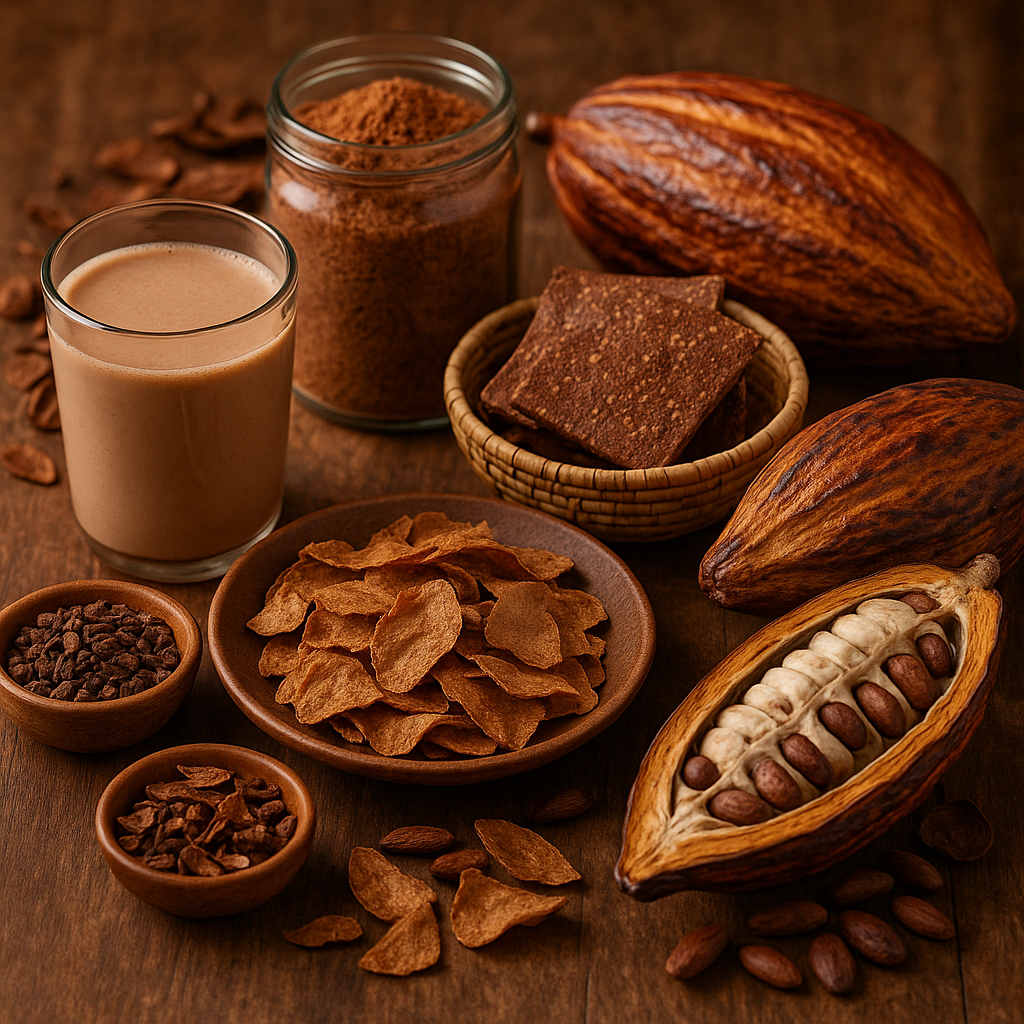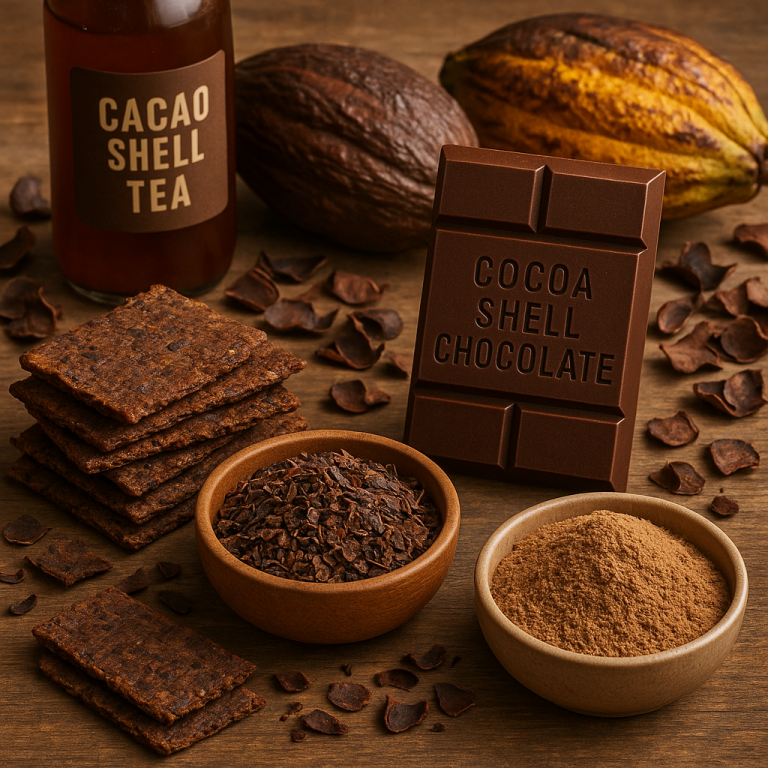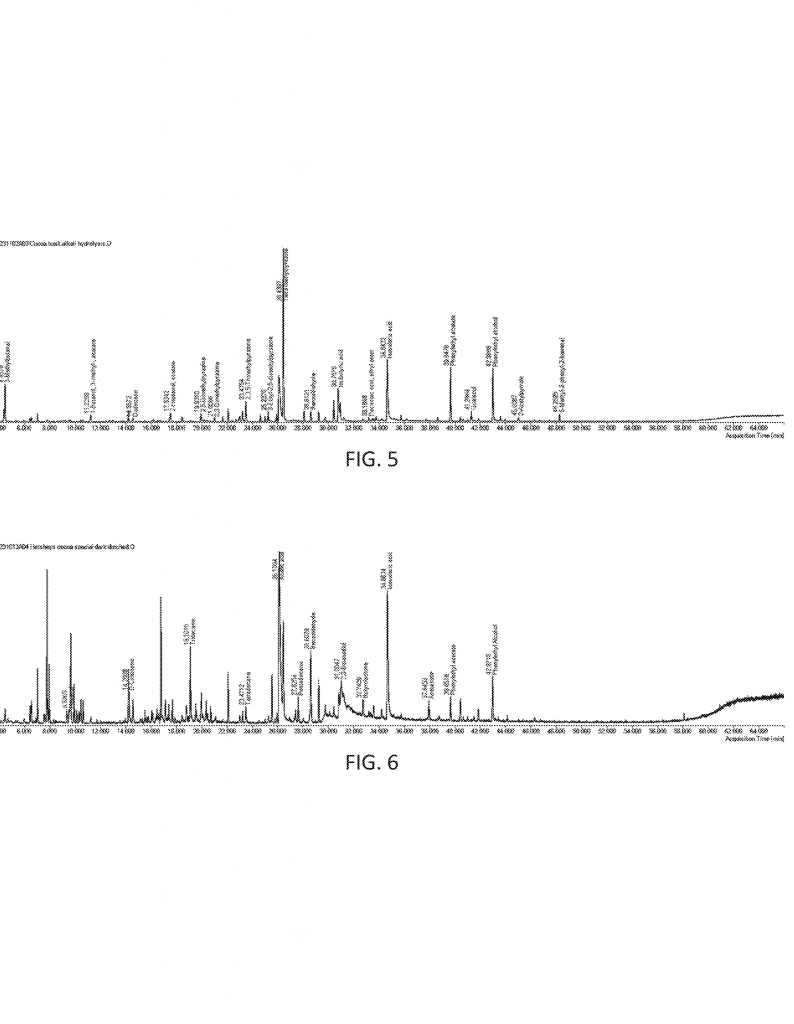CHOCOLATE CONSUMABLES PRODUCED FROM CACAO WASTE PRODUCTS

Invented by Crofts; BreeAnn, Tenney; Kelsey, Head; Brandon, Baker; Lucas, Maxwell; Adam

Chocolate is loved by many, but few know the waste left behind after making it. This patent is about turning that waste into something valuable. Let’s explore how this new invention could change the chocolate and food world forever.
Background and Market Context
Chocolate is one of the most popular treats on the planet. When you think of chocolate, you probably imagine bars, candies, or hot cocoa. But before it lands in your hand, chocolate starts its journey inside a fruit called the cacao pod. This pod holds precious cacao beans, which are the main source of chocolate. Once the beans are taken out to make chocolate, a lot of leftover material remains—cacao shells and cacao pods. These leftovers are often just thrown away or used as simple compost.
The numbers are huge. The outer shell of the cacao pod can make up to 80% of the whole fruit’s weight, and the shell around each cacao bean is about 15% of the bean’s weight. When you add up all the chocolate made worldwide, you get a mountain of waste every year. Most of this waste isn’t used for people’s food. Sometimes, it is burned, sometimes fed to animals, but often it just rots away. That’s a lot of lost value.
In recent years, people have been looking for ways to use food waste. It helps the planet by cutting down on garbage and can save money. The chocolate industry, though, has struggled to use cacao shells and pods. These parts are very tough and hard to grind. If you try to put them in chocolate the old way, they damage machines and make chocolate taste bad or feel gritty. This means most of the shells and pods are never used in food.
On top of that, the world faces growing demand for chocolate and plant-based foods. Prices for cacao beans can swing up and down, and there is pressure to use resources better and make chocolate more sustainable. Finding a safe, tasty, and easy way to use cacao waste in food could change the market. It could lower costs for chocolate makers, offer new types of food, and help the planet by reducing waste.

This patent tackles these problems head-on. It offers ways to turn cacao shells and pods into food ingredients that work and taste good, opening the door for new chocolate products and more sustainable food choices for everyone.
Scientific Rationale and Prior Art
To understand why this invention matters, it helps to know why cacao shells and pods are so hard to use. These parts of the cacao plant are made of something called lignocellulose. That’s a fancy word for a mix of tough fibers—lignin, cellulose, and hemicellulose. These fibers are very strong, like the wood in trees. They make cacao shells and pods hard to break down, even with strong machines or special enzymes. If you roast them, they can get even harder. That’s why most chocolate makers avoid putting them into chocolate.
Some companies have tried to grind cacao shells using expensive or special machines. Others have used very cold temperatures to freeze the shells and make them easier to crush. But these ways cost too much and are not practical for most chocolate makers. When shells are added the old way, they can break machines and make chocolate gritty or unpleasant. Also, the natural flavors locked inside the shells and pods can’t get out because they are trapped in the tough fibers.
What about using the shells and pods as animal feed or compost? These uses don’t add much value. The high fiber, especially lignin, is hard for animals to digest. Burning the waste for energy is common in some places, but it doesn’t help make better food.
Some chocolate powders are made using a process called “Dutching,” which uses an alkaline solution to change the flavor and color of cocoa, making it less sour and more mellow. But this process is applied to cocoa nibs, not the tough shells or pods. Dutching doesn’t solve the problem of breaking down the tough fibers in cacao waste.
Other food industries have used acid or base treatments to break down plant fibers, but there was little work on applying this to cacao waste for food. The idea of using both chemical and enzyme treatments, followed by roasting and grinding, is new for cacao shells and pods. The main goal is to make them easier to grind, better tasting, and able to blend smoothly into foods like chocolate, spreads, or drinks.

This patent builds on the idea that if you can break the tough fibers into smaller pieces—using acid, base, or enzymes—then roast them, you can unlock the flavors and make the shells and pods easy to use in food. It takes lessons from other areas, like making biofuels from plants, where breaking down tough fibers is also a problem. But here, the focus is on food safety, taste, and texture, which are even more important.
Past research showed that when you break down these tough fibers, you can release sugars and proteins. These are the building blocks for flavors that come out when you roast food, like in chocolate or coffee. If you do it right, you get the nice taste and smell people love in chocolate, without the bad flavors or rough texture.
So, while some ideas were out there, no one had put together a simple, practical method to turn cacao shells and pods into smooth, tasty, food-safe powders or pastes for chocolate and other foods. That’s what makes this invention special.
Invention Description and Key Innovations
This patent introduces a new way to turn cacao waste—mainly shells and pods—into ingredients that can go right into chocolate, drinks, and other foods. The trick is in a few simple steps: treat the tough shells and pods with acid or base (or enzymes), then roast and grind them until they’re smooth and tasty. Let’s walk through how it works and why it matters.
Step 1: Treating with Acid, Base, or Enzymes
The shells and pods are soaked in a solution. This can be an acid (like citric acid, lactic acid, or even safe food acids) or a base (like baking soda or lime). Sometimes, special food enzymes are used. The soaking happens at warm temperatures—think hot tap water, but not boiling. This step breaks down the hard fibers inside the shells and pods. It unlocks the building blocks—sugars and proteins—needed for good flavors.
Step 2: Roasting

After soaking, the shells and pods are dried out and roasted. Roasting is important because it creates the deep, rich flavors people love in chocolate. The chemical changes during roasting (like the Maillard reaction) turn the sugars and proteins into yummy smells and tastes. The roasting is done at temperatures similar to those used for roasting coffee or cocoa beans.
Step 3: Grinding
Once roasted, the shells and pods are ready to be ground into a fine powder or paste. This is where the magic of the earlier steps shows up. Thanks to the acid, base, or enzyme treatment, the shells and pods are now much easier to grind. The powders can be very fine—down to 15 microns, which is smaller than a grain of sand and perfect for chocolate. The paste can be mixed with cocoa butter or other fats to make a smooth, spreadable chocolate-like product.
What’s New and Different?
This invention does more than just grind up cacao waste. It solves the old problems: the shells and pods don’t break machines, don’t feel gritty, and don’t taste bad. The patent shows that you can use these powders and pastes as full or partial replacements for regular cocoa powder and chocolate liquor. That means you can make chocolate that tastes, smells, and feels just like normal chocolate—but with upcycled ingredients.
Tests showed that chocolate made with these treated shell and pod powders scored as high as regular chocolate in taste tests. The flavors were rich, chocolatey, and free of strange aftertastes. The color was just as deep as you’d expect from good chocolate. The particles were so small that the chocolate felt smooth and creamy on the tongue.
Flexible and Practical
The process isn’t limited to one type of acid, base, or enzyme. It can use many food-safe chemicals, so it’s easy to adapt for different countries and food laws. The powders can be used in all kinds of foods, from dark, milk, or white chocolate to spreads, drinks, or even plant-based snacks. Because the treated shells and pods have less fat than regular cocoa, they can be used in recipes where you want less fat or where cocoa butter isn’t a good fit.
The process also allows for different particle sizes. You can make fine powders for smooth chocolate or coarser particles for crunchy toppings or mixes. The powders and pastes can be made into instant drink mixes, chocolate spreads, or even concentrated syrups.
Better for the Planet and Wallet
By using what was once waste, chocolate makers can cut costs and waste less. This means more profit and less garbage. It also helps farmers and factories by giving value to every part of the cacao fruit. The process can reduce the environmental impact of chocolate and help make chocolate more affordable.
Safe and Tasty
The patent pays close attention to food safety. All the acids, bases, and enzymes are food-grade. The roasting step kills germs and locks in flavor. The end products are safe to eat and keep well on the shelf, just like regular chocolate or cocoa powder.
Key Takeaways
This invention offers a simple, flexible, and powerful way to turn cacao shells and pods into valuable food ingredients. It opens up new possibilities for chocolate, drinks, and plant-based foods, all while cutting waste and saving money. The process is practical, scalable, and ready for real-world use.
Conclusion
The journey from cacao fruit to chocolate bar leaves behind a mountain of shells and pods. For years, this waste was a problem with no good solution. This patent changes all that. By using smart treatments—acid, base, or enzymes—followed by roasting and grinding, it unlocks the value hidden inside cacao waste. The result is a smooth, tasty ingredient that can stand toe-to-toe with traditional chocolate in flavor, texture, and aroma.
This invention is a win for chocolate lovers, food makers, and the planet. It makes chocolate production more sustainable, reduces waste, and opens new doors for creative food products. As the world looks for better ways to feed people and care for the earth, this approach to upcycling cacao waste is both timely and important. The future of chocolate—and food in general—may be a lot greener, thanks to new ideas like these.
Click here https://ppubs.uspto.gov/pubwebapp/ and search 20250212908.


